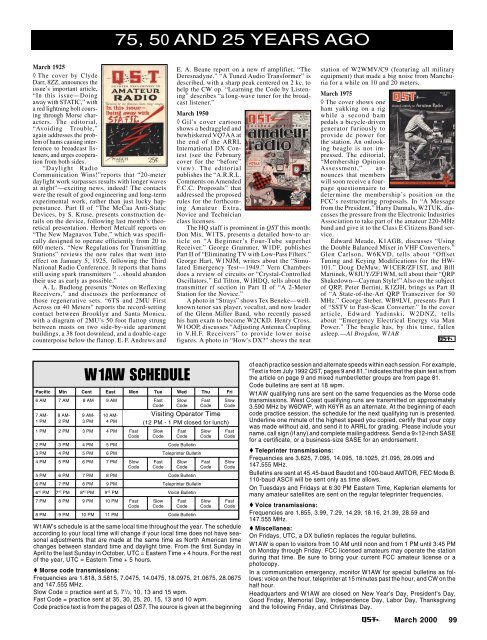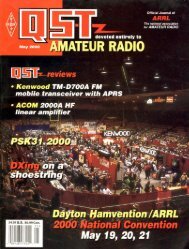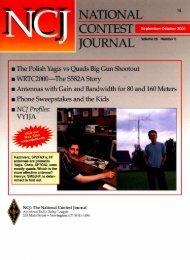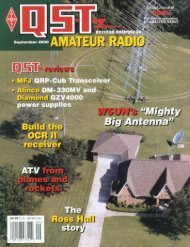It is with deep regret that we recordthe passing of these amateurs.W1BDV, James P. Saunders, York Beach, MEND1D, Thomas J. Reynolds, Islesboro, MEAA1ER, Edward J. Donohue, Windsor Locks, CT*WA1GSB, Charles T. Marshall, Roslindale, MAK1JJJ, Alderico Fruzzetti, Bridgewater, MAW1KVM, Albin Sheputa, Thompson, CT*K1MEM, James Dionne, Sudbury, MAKA1QGF, Benjamin N. Estra, Stratford, CTW1WUZ, John Sabo, Southport, CTN2CJT, James C. Davis, Fitchburg, MAKD2CR, Leonard J. Kravitz, Woodbury Heights, NJW2DNN, Samuel C. Macy, Elgin, ILWA2FVF, Theodore F. Bollen, Flushing, NYW2GZ, Leonard L. Furman, Deltona, FLW2PDT, Lisle A. Snow, Lyons, NYK2QEZ, George Bernstein, Tamarac, FLWB2RNS, Colin C. Corke, Albion, NYNW2T, David E. Schwittek, Springwater, NYAI2W, Ed Dombert, Hartsville, NYK3AJQ, Herman A. Christen, Pittsburgh, PAKG3C, John J. Scull, Moscow, PAN3CUS, Stanley A. Greenstein, Bryn Mawr, PAWA3EBA, Richard D. Donnelly, Clarks Mills, PAN3IYJ, Frank S. Marshall, College Park, MDK3KLI, George E. Stockdill, Brookville, PAW3KYW, Bruce R. Wood, Warren, PAW3LQD, Leo C. Kelley, Altoona, PAN3MVH, Bernice M. Hampson, Emmitsburg, MDN3XT, Thomas E. Moyers, Woodbridge, VAK3WV, William A. Vogan, Owings, MDWA3ZFM, John A. Valentie, Campbelltown, PAW4ADO, Otis K. Wolfe, Rose Hill, VAKE4BYK, Ottis P. Gray, Tuscaloosa, ALKS4CT, Peter J. Codones, Haines City, FLWA4EKM, Alfred A. Hook, Pompano Beach, FLW4FCC, George R. Alsobrook, Memphis, TN*K4GFP, William C. Johnston, Oakton, VA*KB4GI, Carlos H. Purtee, Jackson, TNW4HHK, Paul M. Wilson, Collierville, TNW4HTG, Elmer G. Davis, Lexington, NCWA4JDB, Gene W. Starr, Palm Bay, FLK4KQE, Howard G. Dodd, Haleyville, ALW4MJW, Roy J. Dickson, Winston Salem, NCK4MVB, Mary E. Blocher, Highland Heights, KYWA4OJU, R. E. Crocker, Charlotte, NCK4PYA, Crosby Sparks, Winchester, KYN4RZJ, Philip D. Brown, Fairhope, ALW4SXZ, Gerard T. Becknell, Forest City, NC*K4TI, Donald P. Huddler, Columbus, INW5AYQ, Charles B. Perdue, Biloxi Ms, MSK5BSY, Cecil E. Cooper, Houston, TXSILENT KEYSK5ERW, Marjorie A. Larison, Kingsbury, TXKB5FDV, Amet Deniz Tor, Corpus Christi, TXKF5JU, M. Scott Tipton, Dallas, TX*KB5JY, Charles B. Martin, Los Alamos, NMW5LFS, Arthur A. Harban, Bartlesville, OKW5LHX, Amos Peters, Taylor, TX*W5LWS, James P. Allen, Natchez, MSKA5MNT, Clarence E. Smith, Richton, MSKF5NT, Paul E. Osborn, Palestine, TXN5OWQ, Quinn C. Farabee, Fredericksburg, TXND5W, R. C. Arens, Oklahoma City, OKKC5YJV, Michael Glover, Diboll, TXKD6AEP, Jean Edmondson, Willits, CAW6ARJ, William R. Mattison, Auburn, CAW6BFF, John L. Willette, Stockton, CAN6BQ, Walter A. Hopkins, San Jose, CAWB6GRY, Nicholas J. Pardi, Apple Valley, CANH6IB, Willard M. Eller, Wailuku, HIWA6JIX, Bob G. McMullen, Lancaster, CAW6KZJ, Laurence A. Daily, San Carlos, CAW6LZI, Harry J. Moulin, Lafayette, CAWM6M, Daniel G. Dietz, Scotts Valley, CAWB6PJY, Lavonne C. Scanlon, Modesto, CA*KJ6QQ, Hugh C. Foster, Grants Pass, ORWA6SUO, William O. Allen, Citrus Heights, CAWB6UAL, William H. Livingston, DiamondSprings, CAK6UE, Horton C. Williams, Othello, WAK7AAG, Alex Muir, Edmonds, WAW7BLI, Ralph W. Ivie, Kimberly, IDW7CMO, Norman S. Moberg, Puyallup, WAW7CSG, Harold W. Barth, Spokane, WAKA7DCX, Joseph E. Jenks, Tacoma, WAKA7FEE, John R. MacKenzie, Portland, OR*K7FE, Frank A. Exum, Denver, COKB7FMP, Victor W. Jones, Sumner, WAW7FOO, Edward A. Harbidge, MountlakeTerrace, WAKA7HWK, Harry W. Edwards, Everson, WAW7ITP, Wayne Spoonemore, Dayton, WAW7KBH, George E. Gierke, Seattle, WAKC7KPI, Edward F. Stone, Rochester, WAW7LRB, Chet McCoy, McMinnville, ORW7LZM, John W. Karr, Bellevue, WAW7OZH, Lawrence R. Schumacher, Bozeman, MTW7QS, Luis Torres, Fircrest, WAW7RMV, William H. Evans, Careywood, IDKA7RNK, Peter A. Boving, Yakima, WANO7S, Monte L. Porter, Centralia, WAW7VM, Roy T. Bucy, Des Moines, WAWB8DNE, Hiram W. Brewer, Sebring, FLK8JXF, Donald M. Covert, Chagrin Falls, OHK8KAM, Lois E. Rhodes, Troy, OHK8KDO, Mildred M. Chapin, Oberlin, OHWD8OFL, David A. Lahiff, Adnover, OHW8TEB, Virgil J. Junker, Dayton, OHWA8VSY, Thomas R. Weiss, Norton, OHW8VXG, Lyle E. Handlon, Rollin, MIKD8XU, Harold K. Kidd, Robson, WVW8ZKX, Charles E. Rogers, Akron, OHKA9DJT, Julio R. Gonzalez, Milwaukee, WIW9DMO, N. Scotty Mullikin, Franklin, INN9GWS, Charles H. Apfelstadt, Evansville, INKA9ISH, Malcolm R. Holland, Upland, INW9KKX, Robert L. Streeter, Hendersonville, NCWA9KNK, Billy J. McCollum, Milwaukee, WIWB9KZH, Merrill A. Lewis, Oshkosh, WIW9MPP, Charles Kindt, Beaver Dam, WIWA9MVX, Richard W. Alexander, Muncie, IN*W9NU, John W. Page, Bradenton, FLWA9PAZ, Brayton V. Danner, Lincoln, ILW9PWI, Richard E. Rice, East Alton, ILAA9SN, Robert E. Jacobson, Skokie, ILK0AIE, Albert H. Gull, Edgemont, SDW0AXT, Roger E. Sawyer, Mason City, IAW0DYC, Julien J. Meyer, Benson, MNWA0FUH, Sam J. Beck, Johnston, IAW0IIJ, John J. Hoefer, Shawnee Mission, KSW0OQK, Richard W. Shaw, Kansas City, MOWA0QJK, Edwin E. Woerner, Lincoln, NEAA0QQ, Merle C. Skinner, Logan, NMGI3ILV, James Thompson, Craigavon, NorthernIreland,PA0KSB, K. Spaargaren, Amstelveen, NetherlandsSP9ZD, Henryk Cichon, Katowice, Poland*VE3HC, Fred O. Hammond, Guelph, ON, Canada*VP9C, Colin C. Dumbrille, Smith’s Parish, Bermuda*Life Member, ARRLNote: Silent Key reports must confirm the deathby one of the following means: a letter or notefrom a family member, a copy of a newspaperobituary notice, a copy of the death certificate,or a letter from the family lawyer or the executor.Please be sure to include the amateur’sname, address and call sign. Allow severalmonths for the listing to appear in this column.Many hams remember a Silent Key with a memorialcontribution to the ARRL Foundation. If youwish to make a contribution in a friend or relative’smemory, you can designate it for an existing youthscholarship, the Jesse A. Bieberman MeritoriousMembership Fund, the Victor C. Clark Youth IncentiveProgram Fund, or the General Fund. Contributionsto the Foundation are tax-deductible tothe extent permitted under current tax law. Ouraddress is: The ARRL Foundation Inc, 225 MainSt, Newington, CT 06111.Kathy Capodicasa, N1GZO Silent Key Administrator98 <strong>March</strong> <strong>2000</strong>STRAYSHCA SHORTWAVE DXACHIEVEMENT CERTIFICATE◊ If you have a vintage tube receiver, and listento commercial international shortwave stations,here is your chance to earn a beautifulcertificate. You can get one for receiving, andconfirming, 50, 100, 150 or 200+ countries.The SWL adventure runs until April of 2001.Applicants may use half of their existing shortwaveQSL cards or letters toward the total.The other half must be accumulated sinceJanuary 1, <strong>2000</strong>. There is a special solidstateclass for those who wish to use modernreceivers. Details are available at theHallicrafters Collectors Association Web site:http://www.hallicrafters.org.Special boat anchor surprises will beawarded for the most unusual QSL, the mostcolorful, the youngest and oldest participantsand the most unusual listening post. ContactDuane Fischer, W8DBF, for further informationat: dfischer@tir.com.BOY’S LIFE RADIO CLUB◊ I’m looking for information and artifacts concerningthe Boy’s Life Radio Club, popular inthe late ’50s and early ’60s. Contact BrianCieslak via e-mail at AE9K@arrl.net.FREE SOFTWARE FORTHE ARRL INTERNATIONALDX CONTEST BY N3FJP◊ N3FJP’s International DX Contest LoggingProgram 1.0 is designed for US and Canadianamateurs. The software will check for duplicates,including partials, and write the Cabrillosummary file. The software is free and availablefor downloading on the Web at: http://members.aol.com/snkdavis/page1.html.I would like to get in touch with…◊…Amateur Radio operators who are alsoamateur astronomers. Xue-Jun Zhang,BD2CR, PO Box 80, Fangxiao, Daqing,163161 China.◊…anyone who might wish to Elmer a prospectiveSudanese ham via e-mail. Nader AliOmer, naderomer@yahoo.com.◊...any amateurs who served aboard the USSShangri-La, CV, CVA, CVS-38, any timebetween 1944-1971. Please contact BobHayner, N2UDO, at n2udo@arrl.net.WANTED: WILKINSONAUTOPATCH INFO◊ I am looking for a schematic and otherinformation for a Wilkinson ElectronicsWERAP-200 autopatch. Please e-mail JimBremer, KE6OUA, at ke6oua@aol.com.Next Stray
75, 50 AND 25 YEARS AGO<strong>March</strong> 1925◊ The cover by ClydeDarr, 8ZZ, announces theissue’s important article,“In this issue—Doingaway with STATIC,” witha red lightning bolt coursingthrough Morse characters.The editorial,“Avoiding Trouble,”again addresses the problemof hams causing interferenceto broadcast listeners,and urges cooperationfrom both sides.“Daylight RadioCommunication Wins!”reports that “20-meterdaylight work surpasses results with longer wavesat night”—exciting news, indeed! The contactswere the result of good engineering and long-termexperimental work, rather than just lucky happenstance.Part II of “The McCaa Anti-StaticDevices, by S. Kruse, presents construction detailson the device, following last month’s theoreticalpresentation. Herbert Metcalf reports on“The New Magnavox Tube,” which was specificallydesigned to operate efficiently from 20 to600 meters. “New Regulations for TransmittingStations” reviews the new rules that went intoeffect on January 5, 1925, following the ThirdNational Radio Conference. It reports that hamsstill using spark transmitters “…should abandontheir use as early as possible.”A. L. Budlong presents “Notes on ReflexingReceivers,” and discusses the performance ofthose regenerative sets. “6TS and 2MU FirstAcross on 40 Meters” reports the record-settingcontact between Brooklyn and Santa Monica,with a diagram of 2MU’s 50 foot flattop strungbetween masts on two side-by-side apartmentbuildings, a 38 foot downlead, and a double-cagecounterpoise below the flattop. E. F. Andrews andE. A. Beane report on a new rf amplifier, “TheDeresnadyne.” “A Tuned Audio Transformer” isdescribed, with a sharp peak centered on 2 kc, tohelp the CW op. “Learning the Code by Listening”describes “a long-wave tuner for the broadcastlistener.”<strong>March</strong> 1950◊ Gil’s cover cartoonshows a bedraggled andbewhiskered VQ7AA atthe end of the ARRLInternational DX Contest(see the Februarycover for the “before”view). The editorialpublishes the “A.R.R.L.Comments on AmendedF.C.C. Proposals” thataddressed the proposedrules for the forthcomingAmateur Extra,Novice and Technicianclass licenses.The HQ staff is prominent in <strong>QST</strong> this month:Don Mix, W1TS, presents a detailed how-to articleon “A Beginner’s Four-Tube superhetReceiver.” George Grammer, W1DF, publishesPart II of “Eliminating TV with Low-Pass Filters.”George Hart, W1NJM, writes about the “SimulatedEmergency Test—1949.” Vern Chambersdoes a review of circuits or “Crystal-ControlledOscillators.” Ed Tilton, W1HDQ, tells about thetransmitter rf section in Part II of “A 2-MeterStation for the Novice.”A photo in “Strays” shows Tex Beneke—wellknowntenor sax player, vocalist, and now leaderof the Glenn Miller Band, who recently passedhis ham exam to become W2CKD. Henry Cross,W1OOP, discusses “Adjusting Antenna Couplingin V.H.F. Receivers” to provide lower noisefigures. A photo in “How’s DX?” shows the neatstation of W2WMV/C9 (featuring all militaryequipment) that made a big noise from Manchuriafor a while on 10 and 20 meters.<strong>March</strong> 1975◊ The cover shows oneham yakking on a rigwhile a second hampedals a bicycle-drivengenerator furiously toprovide dc power forthe station. An onlookingbeagle is not impressed.The editorial,“Membership OpinionAssessment,” announcesthat memberswill soon receive a fourpagequestionnaire todetermine the membership’s position on theFCC’s restructuring proposals. In “A Messagefrom the President,” Harry Dannals, W2TUK, discussesthe pressure from the Electronic IndustriesAssociation to take part of the amateur 220-MHzband and give it to the Class E Citizens Band service.Edward Meade, K1AGB, discusses “Usingthe Double Balanced Mixer in VHF Converters.”Glen Carlson, W6KVD, tells about “OffsetTuning and Keying Modifications for the HW-101.” Doug DeMaw, W1CER/ZF1ST, and BillMartinek, W8JUY/ZF1WM, tell about their “QRPShakedown—Cayman Style!” Also on the subjectof QRP, Peter Bertini, K1ZJH, brings us Part IIof “A State-of-the-Art QRP Transceiver for 50MHz.” George Steber, WB9LVI, presents Part Iof “SSTV to Fast-Scan Converter.” In the coverarticle, Edward Yadinski, W2DNZ, tellsabout “Emergency Electrical Energy via ManPower.” The beagle has, by this time, fallenasleep.—Al Brogdon, W1ABW1AW SCHEDULEPacific Mtn Cent East Mon Tue Wed Thu Fri6 AM 7 AM 8 AM 9 AM Fast Slow Fast SlowCode Code Code Code7 AM- 8 AM- 9 AM- 10 AM-Visiting Visiting Operator Time1 PM 2 PM 3 PM 4 PM (12 PM - 1 PM Time closed for lunch)1 PM 2 PM 3 PM 4 PM Fast Slow Fast Slow FastCode Code Code Code Code2 PM 3 PM 4 PM 5 PM Code Bulletin3 PM 4 PM 5 PM 6 PM Teleprinter Bulletin4 PM 5 PM 6 PM 7 PM Slow Fast Slow Fast SlowCode Code Code Code Code5 PM 6 PM 7 PM 8 PM Code Bulletin6 PM 7 PM 8 PM 9 PM Teleprinter Bulletin6 45 PM 7 45 PM 8 45 PM 9 45 PM Voice Bulletin7 PM 8 PM 9 PM 10 PM Fast Slow Fast Slow FastCode Code Code Code Code8 PM 9 PM 10 PM 11 PM Code BulletinW1AW’s schedule is at the same local time throughout the year. The scheduleaccording to your local time will change if your local time does not have seasonaladjustments that are made at the same time as North American timechanges between standard time and daylight time. From the first Sunday inApril to the last Sunday in October, UTC = Eastern Time + 4 hours. For the restof the year, UTC = Eastern Time + 5 hours. Morse code transmissions:Frequencies are 1.818, 3.5815, 7.0475, 14.0475, 18.0975, 21.0675, 28.0675and 147.555 MHz.Slow Code = practice sent at 5, 7 1 /2, 10, 13 and 15 wpm.Fast Code = practice sent at 35, 30, 25, 20, 15, 13 and 10 wpm.Code practice text is from the pages of <strong>QST</strong>. The source is given at the beginningW1AW Scheduleof each practice session and alternate speeds within each session. For example,“Text is from July 1992 <strong>QST</strong>, pages 9 and 81,” indicates that the plain text is fromthe article on page 9 and mixed number/letter groups are from page 81.Code bulletins are sent at 18 wpm.W1AW qualifying runs are sent on the same frequencies as the Morse codetransmissions. West Coast qualifying runs are transmitted on approximately3.590 MHz by W6OWP, with K6YR as an alternate. At the beginning of eachcode practice session, the schedule for the next qualifying run is presented.Underline one minute of the highest speed you copied, certify that your copywas made without aid, and send it to ARRL for grading. Please include yourname, call sign (if any) and complete mailing address. Send a 9×12-inch SASEfor a certificate, or a business-size SASE for an endorsement. Teleprinter transmissions:Frequencies are 3.625, 7.095, 14.095, 18.1025, 21.095, 28.095 and147.555 MHz.Bulletins are sent at 45.45-baud Baudot and 100-baud AMTOR, FEC Mode B.110-baud ASCII will be sent only as time allows.On Tuesdays and Fridays at 6:30 PM Eastern Time, Keplerian elements formany amateur satellites are sent on the regular teleprinter frequencies. Voice transmissions:Frequencies are 1.855, 3.99, 7.29, 14.29, 18.16, 21.39, 28.59 and147.555 MHz. Miscellanea:On Fridays, UTC, a DX bulletin replaces the regular bulletins.W1AW is open to visitors from 10 AM until noon and from 1 PM until 3:45 PMon Monday through Friday. FCC licensed amateurs may operate the stationduring that time. Be sure to bring your current FCC amateur license or aphotocopy.In a communication emergency, monitor W1AW for special bulletins as follows:voice on the hour, teleprinter at 15 minutes past the hour, and CW on thehalf hour.Headquarters and W1AW are closed on New Year’s Day, President’s Day,Good Friday, Memorial Day, Independence Day, Labor Day, Thanksgivingand the following Friday, and Christmas Day.<strong>March</strong> <strong>2000</strong> 99
- Page 6 and 7:
March 2000 Volume 84 Number 3David
- Page 11 and 12:
THE AMERICAN RADIORELAY LEAGUE INC
- Page 14:
Get to Know Your Section ManagerThe
- Page 18:
Senate CommerceChairman andPresiden
- Page 22 and 23:
GEORGE DOMINICK, W4UWCLooking for a
- Page 26 and 27:
CORRESPONDENCEYour opinions count!
- Page 30 and 31:
By Stephen Stuntz, N0BFImagine ridi
- Page 32 and 33:
By David A. Rosenthal, N6TSTDXing W
- Page 34 and 35:
It was a ham’s dream, sitting onM
- Page 36 and 37:
always start at the beginning of me
- Page 38 and 39:
An insideview of theQRSerprototype.
- Page 40 and 41:
Kits and BoardsWhile the original T
- Page 42 and 43:
TT2 PerformanceKeying quality with
- Page 44 and 45:
Figure 1—Schematic of the meter-m
- Page 46 and 47:
Figure 1—Schematic of the Simple
- Page 48 and 49:
tacts I had while using this transm
- Page 50 and 51: chandisers are free to develop “s
- Page 52 and 53: WORKBENCHPROJECTS AND INFORMATION F
- Page 54 and 55: THE HELP DESKSchematic Symbols52 Ma
- Page 56 and 57: paddle. This can be done with eithe
- Page 58 and 59: creator) was providing free PSK31 s
- Page 60 and 61: By H. Ward Silver, N0AXTest Your Kn
- Page 62 and 63: HINTS & KINKSA SIMPLE ANTENNA FLIPP
- Page 64 and 65: By Dave Patton, NT1N2000 Annual Mee
- Page 66 and 67: The Board welcomed three new Vice D
- Page 68 and 69: Craigie nominated Mr. Butler. Mr. B
- Page 70 and 71: D.C., with the specific responsibil
- Page 72 and 73: Table 1Elecraft K2, serial number 0
- Page 74 and 75: two inductors. Don’t let this hap
- Page 76 and 77: Like most transceivers these days,
- Page 78 and 79: Table 2Alinco DJ-V5TH, serial numbe
- Page 80 and 81: FCC NewsENHANCED AMATEUR ENFORCEMEN
- Page 82 and 83: tem is not legal to use as it’s c
- Page 84 and 85: chance to do it. It may be several
- Page 86 and 87: officials and the hundreds of train
- Page 88 and 89: THE WORLD ABOVE 50 MHZDr. Ernest K.
- Page 90 and 91: EME AnnalsEME (moonbounce) standing
- Page 92 and 93: DIGITAL DIMENSIONWinLink 2000: A Wo
- Page 94 and 95: From the Mailbag…Throughout the y
- Page 96 and 97: AT THE FOUNDATIONSpringing with New
- Page 98 and 99: (156.7 Hz), 146.52. Adm: $2. Tables
- Page 102 and 103: CONTEST CORRALFeedbackIn the 1999 A
- Page 104 and 105: By Dan Henderson, N1NDContest Branc
- Page 106 and 107: Affiliated Club Competition Results
- Page 108 and 109: 1999 IARU HF WorldChampionship Resu
- Page 110 and 111: N5XU (+KA5WSS,KM5FA,N3TNN)390,104 8
- Page 112 and 113: RW4AA 1,299,804 2121 172 ARW3GU 879
- Page 114 and 115: Revised 1999 June VHF QSO Party Rov
- Page 122: has been around for some time, is a
- Page 126: 154, WB5ZED 232. Tfc: K5WOD 4, NOKW
- Page 130: Bethpage, NY. Bob Wexelbaum, W2ILP,
- Page 134: NEW HAMPSHIRE: SM, Mike Graham, K7C
- Page 138: 136longtime member N6DOC. Installat
- Page 142: tion of the digital network within
- Page 146: DEC, EC, ASM, and cabinet member at
- Page 150:
148agencies have had a working rela
- Page 156:
CALL SIGN NAME BADGES. Club logos o
- Page 160:
COMPUTERS - WANTED early Pre-1980 m
- Page 176:
Index of AdvertisersADVERTISING DEP
















